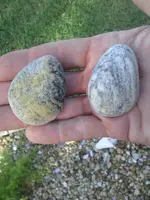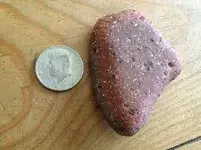Blow are a sample of cut Ballast Stones I found hidden inside a small dune....I confirmed these with the local museums, as Ballast Stones from the 1554 fleet of which 4 ships ships crashed in to what is now known as South Padre Island, Texas during an late April tropical storm, one of the 4 ships was able to make it way to Havana, Cuba, but was scuttled there as it was no longer sea worthy. The Galleon these stones came from was the Santa María de Yciar, which was accidentally dredged up while cutting the "Mansfield Channel or Cut", during the early 1950's, separating So and No Padre Islands as we know it today... I was searching for gold and other valuable objects from this fleet, with some special technology that I use for treasure hunting, when these stones were detected inside the small dune on the So Padre Island side of the cut.....I also confirmed from the local museums, that on the return trip, some captains would place some Ballast Stones like these in the ship for additional ballast, if there was room and if needed, as these stones contained various amounts of either gold or silver and when they got back to Spain they could process the gold or silver from these stones without paying a tax on the gold...unlike was what taxed from the manifest. Once identified and known, I have since found several of these scattered within the dredge spoils of the Mansfield Cut.
Klondike









